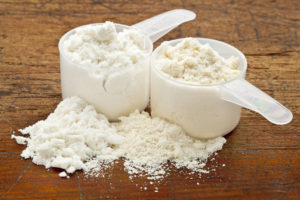Protein is an important part of a healthy diet. Do we actually know how much we should be consuming daily and when? The answer is not as clear-cut as we think.
How much Protein?
New research suggests that the current protein guidelines for healthy adults could be underestimating our needs by 30-40%. This is because the traditional method to determine protein and amino acid requirements, the nitrogen balance technique, has many caveats leading to an underestimation of our needs.
Currently, researchers are using a new technique called the indicator amino acid oxidation (IAAO) method. In this method, essential amino acids (amino acids which must be supplied in our diet) are labeled with the stable isotope carbon-13 (13C). The labeled 13C in the carbon dioxide (13CO) we breath out is used to measure needed protein. This method is based on the principle that excess amino acids, unlike carbs and fats, cannot be stored in the body. According to this method, if you are a healthy adult, you should be taking in on average 1.5-2.2g/(kgday) of protein daily as part of a complete diet, compared to the currently suggested 0.8-1.4g/(kgday).

When to eat?
Another factor in protein intake is when during the day we consume it. In North America, we tend to eat most of our protein in the evening. We consume, on average, 38g during dinner and only 13g for breakfast. Researchers found that consuming a moderate amount equally 3 times a day stimulates 25% more muscle building than an uneven consumption. If you over consume in a single meal your body cannot store the excess amino acids so they will go to waste.
To look at this a different way, a single 12-ounce portion of lean beef, has a similar effect on muscle building as a 4-ounce portion. This could be especially important in physically active older adults, where low protein meals drastically decrease muscle synthesis.

What does this mean for you?
Most athletes exceed the suggested daily protein level, however many could actually be below the optimal level due to the skewed nature of consumption. This could slow muscle building and recovery. To maximize muscle synthesis, athletes should aim for 4 daily meals of 20 grams of protein.
High-protein diets can offer great benefits however; consistent excessive intake can cause serious adverse effects. The take home message is to evenly distribute your protein intake and to stay away from that 24-oz steak. We recommend many of our clients take their personalized supplement twice a day, which will ensure proper spacing of intake.
References:
Mamerow MM1, Mettler JA1, English KL1, Casperson SL2, Arentson-Lantz E1, Sheffield-Moore M2, Layman DK3, Paddon-Jones D4. Dietary protein distribution positively influences 24-h muscle protein synthesis in healthy adults. J Nutr. 2014 Jun;144(6):876-80.
Arentson-Lantz E, Clairmont S, Paddon-Jones D, Tremblay A, Elango R. Protein: A nutrient in focus. Appl Physiol Nutr Metab. 2015 Aug;40(8):755-61
Phillips SM1, Van Loon LJ. Dietary protein for athletes: from requirements to optimum adaptation. J Sports Sci. 2011;29 Suppl 1:S29-38

